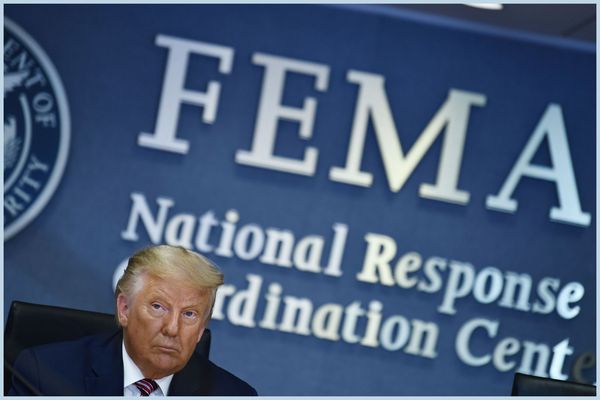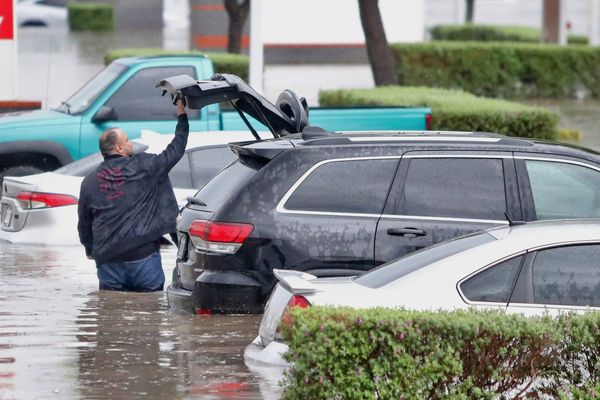If you look closely at Robert Richards's white weatherboard home, you'll see a layer of black dust.
It covers the side of his house, sometimes it sits on his cars and even gets inside his front door.
"Quite often I come out here, probably every two weeks, and give it a brush and hose down," he says from the side of his house in Brooklyn in Melbourne's west.
"Probably 10 days later we are back to this," he says, wiping away a thick layer of dust with his hand.
Mr Richards's home sits below the West Gate Freeway — the major road link between the city and Melbourne's west.
It is also close to heavy industry.
He moved here 30 years ago because the area was affordable.
The noise from the freeway has bothered him in the past, but he says he never knew to worry about the air quality.
Even when a large air monitor was built on land next to his house, he didn't get any information about why it was there or what data it was collecting.
"I just want to know why it's there, what it is registering," he says.
"I think there should at least be something dropped in your mailbox explaining the outcome and what this station is for, and a bit of data and detail so the lay person can understand."
While Mr Richards was unaware of the air monitor's purpose, it has been silently capturing data about the air he breathes in.
And that data is worrying scientists.
In Australia, air pollution has long been a silent killer
While many of us know little about air pollution — it's a health hazard scientists have increasingly been turning their attention to.
Melbourne University scientists on Friday released new modelling which shows traffic pollution likely claims more than 11,000 Australian lives each year.
The scientists based their work on a major New Zealand study which was peer reviewed.
Using the same methodology they recalculated the figure, for Australia.
Their estimate was staggering.
To understand air pollution, we need to know where it comes from.
Air pollution can be caused by both man-made and natural factors. Burning fossil fuels, heavy industry, wood-fired heaters and traffic emissions all cause air pollution, but so do dust storms and bushfire smoke.
Lou Irving, a respiratory physician at the Peter MacCallum Cancer Centre and the Royal Melbourne Hospital, says air pollution is so deadly because it can cause a range of different illnesses in the body.
"There are affects on the lungs … and two obvious examples are it can cause asthma and can also trigger asthma attacks," he says.
"And then prolonged exposure to some forms of pollution can cause lung cancer."
But the health impacts of air pollution, he says, go well beyond the lungs, because some air pollution particles are so small they can be absorbed into our blood stream.
"It is now known, for example, that traffic pollution exposure over a long period of time can cause heart attacks, stroke, can be associated with dementia, diabetes, low-birth-weight pregnancies, a wide range of system effects."
Part of the problem in addressing these health concerns, he says, is the lack of understanding about the issue amongst the wider public.
Dr Irving says while we have seen things like the "slip, slop, slap" public health campaigns to reduce the rates of skin cancer in Australia, we haven't seen a mass public health campaign about air pollution.
"There are a lot of ways we can achieve cleaner air and there are a lot of ways we can prevent what could be a catastrophe if we don't do something about it," he says.
Retired environmental scientist Keith Loveridge agrees more needs to be done.
He taught at RMIT University and helped Maribyrnong City Council in Melbourne's west draft its air pollution policy, before recently retiring.
He says while scientists have long known the health impacts of air pollution, successive state and federal governments have failed to adequately address the problem and protect communities from harm.
As an example, he says, Australia has very different air quality standards to those recommended by the World Health Organisation.
Mr Loveridge says the WHO has recognised the problems with PM2.5, a fine particulate matter which he says is the main thing that comes out of diesel.
"The WHO guidelines are now 5 micrograms per cubic metre [as the standard average annual air-quality level], but in Victoria we are still 8 micrograms per cubic metre," he says.
That gap in air quality standards, he explains, means communities can be exposed to air quality which would be considered poor under WHO guidelines, but is marked as good under Australian standards.
"I have read where some scientists reckon Australia is about 10 years behind when it comes to the rest of the OECD countries, when it comes to working out what is the safer levels of air pollution," he says.
In Melbourne's west, scientists raise the alarm
Dr Irving agrees Australia generally has good air quality compared to some countries, but says what worries scientists is what is known as hotspots — or areas with the highest air pollution in Australia.
The Australian Conservation Foundation last year complied a list of the 10 most-polluted suburbs in Australia, based on Federal Government data which collates emissions from big industrial polluters.
It found Mt Isa in Queensland had the highest rate of air pollution, and Queensland had four of the 10 highest regions for air pollution in the country.
But it didn't include traffic pollution data.
In the inner west of Melbourne, it is a combination of heavy industry and the many thousands of trucks which travel through suburban streets each day, on their way to the nearby Port of Melbourne or other industrial sites in the area, have led to concerns about air quality.
A 2020 Victorian Government report found the region had the highest rate of childhood asthma in the state, and higher than average hospital admissions for diseases linked to air pollution, including heart disease, lung cancer and stroke.
That report analysed the results from air-quality monitors in the inner west — including the monitor next to Mr Richards's house.
In 2019 that monitor recorded the highest average annual concentration of PM2.5 at 10 — which is double what the World Health Organisation recommends, and above the Australian standard.
That monitor also recorded 41 days in 2019 where the daily Australian PM10, another type of particulate matter larger than PM2.5, objectives were exceeded.
It wasn't the only site with worrying recordings.
That same report found Melbourne had recorded 297 instances where air pollution had exceeded reporting standards between 2010-2020, and of those 201 had occurred in the inner west of the city.
The report authors echoed Mr Richards's concerns about a lack of information flowing back to the local community.
"Current reporting is primarily on websites, which are not accessible for many community members, and the language in the reports is highly technical," the 2020 report found.
That report concluded that "air pollution is a widespread and alarming problem in the inner west".
And it also sounded the alarm — with more people moving into the area — air pollution was only going to grow as a problem if it wasn't addressed.
New study calculates health risk of air pollution for children
Clare Walter is one of the scientists who has used data from the monitor next to Mr Richards's house.
It was one of six monitors added to the region as part of the West Gate Tunnel project, which will create a second road link to the city's west.
While scientists and community groups have long criticised a lack of adequate air monitoring in the region, these newer stations have allowed scientists to take a deeper look at the health impacts of higher pollution levels.
Ms Walter's most recent study, which is yet to be published, has used the readings from these monitors to examine the asthma risk for children in the inner west of Melbourne, with a particular focus on traffic pollution.
The study compares the data from the newer West Gate monitors, to data from a nearby Footscray park air monitor owned by Victoria's Environmental Protection Authority (EPA), which was previously used to calculate air quality and health risks for the area.
"The air pollution in these areas is much higher than the background EPA reference monitor," she says.
"Nitrogen dioxide, which is the pollution which tends to be most representative of traffic, was 50 per cent higher at the roadside locations."
Ms Walter then used this newer data to calculate the asthma risk for children.
She found those air pollution levels raised the risk of children developing asthma by up to 13 per cent and they increased the chance of a child with asthma experiencing the illness by 33 per cent.
Ms Walter says it is important to understand her study looks at the risks of asthma associated with the air quality along major roads, and it is likely children wouldn't spend all of their time in these locations.
But still, the results, she says, show the health risks of air pollution for children.
"It is a significant figure, particularly when you consider children in this area already have a high prevalence of asthma," she says.
She also used data from a relatively new community air quality monitor which is located along a major truck route.
When the health scientist used that data she found there was a 28 per cent increase in the risk of childhood asthma.
Ms Walter's work has also previously looked at how close childcare centres and schools are built to major truck routes particularly in the inner west, which she has compared to rules which are in place for sensitive sites in California.
"In this particular area of Melbourne, which has big issues with the freight on trucks going through, 21 childcare centres and eight schools were within 150 metres or closer to a high density route of traffic, so over 13,000 trucks per day," she explains.
"Those schools would all breach Californian guidelines which have been in place for 20 years."
Ms Walter says while these are difficult problems to solve, more can be done to protect children from harm.
She wants to see more vegetation barriers being built around sensitive sites, and says other measures that could be considered include buffer zones being included between major roads and where children play and ideally the creation of "low-emission zones prohibiting trucks from taking routes outside of childcare centres and schools during school hours."
Sydney community group joins global movement
While the NSW Environment Protection Authority reported generally improved air pollution levels for 2022 due to the cooler, wet weather, it is an issue that has long concerned environmental groups in Sydney's inner west.
Community Environmental Monitoring was formed out of a concern that the area didn't have enough monitors particularly near major roads and construction sites.
The group looked to Germany where community groups there had come up with ways to make inexpensive monitors.
"We followed their example and we built monitors," group member Charlie Pierce says.
Globally, he says, there are now about 13,000 of these homemade monitors in use and about 100 in Sydney.
So, what have the Sydney monitors detected?
He says during the construction phase of WestConnex his group noticed high air pollution peaks during the day, including at locations near schools.
"For the daytime, in the construction time, an hourly reading would go well above 24 microgram per cubic metre [limit]," he says.
This data led Mr Pierce's group to a couple of realisations.
The first, he says, was an understanding that "most pollution is local" and in the inner west of Sydney, it was coming from local industry and roads.
Mr Pierce says his group also realised that the government monitoring systems simply don't have enough monitors close to air pollution emission points to read what is happening right across a city.
He says because air pollution can be highly localised, he doesn't believe it is reasonable for governments alone to do all the required air monitoring.
Mr Pierce's group are now discussing ways to invest in portable monitors so they can move monitors to areas closer to sources of air pollution.
A spokesperson for NSW Transport says air quality along the Parramatta Road corridor has improved by 10 to 15 per cent since the opening of the WestConnex M4 tunnels, with less traffic on surface roads.
The government has also installed air quality monitoring stations at key locations with live data available for the public.
No transition plans for trucking industry
In Australia, one of the big sources of air pollution, particularly in our cities, are trucks.
A Grattan Institute report found while trucks represent "only 3 per cent of Australia's road vehicles, they create about a quarter of transport related air pollution".
Peter Anderson is the chief executive of the Victorian Transport Association, which represents the trucking industry.
He is frank about the industry's air pollution problem.
Mr Anderson says the average age of a truck on an Australia road is 17 years.
The age of the fleet is important.
The Grattan Institute report showed that pre-1996 trucks emit 60 times the particulate matter and eight times the nitrogen oxides of a new truck.
Mr Anderson says the age of Australia's truck fleet all comes down to dollars.
New trucks can cost $250,000, but an old truck can sometimes be purchased for a fifth of that cost.
And while the longer-haul routes require newer, more reliable trucks, older trucks are essentially shifted to shorter, inner-city runs where they can keep going for years.
"The real issue for us is that a truck doesn't die, it doesn't get pushed into a ball and sold as scrap," Mr Anderson says.
"If it gets to the point where it can't be driven safely, it is stripped for spare parts and put back into an old truck again."
While many of the industry's critics are calling for an electric truck revolution, Mr Anderson believes that is a long way off.
He says a realistic next step for the industry is to shift to newer, lower emitting diesel trucks.
The trucking leader says he understands the industry needs to change, but he wants governments to create a clear transition plan for the industry, with incentives for companies, before regulations come into play.
Calls for pollution to be addressed
Mr Anderson isn't the only one calling for governments to do more.
Dr Irving believes now is the time for state and federal governments to show leadership on the issue.
A Victorian Department of Environment spokesperson says there are plans to "target air pollution and improve air quality as we tackle the challenges of climate change and population growth" over the next decade.
"As part of the strategy we will advocate for strong national standards, improve air quality monitoring and provide better access to information for the community."
The Federal Government says Australia generally has good air quality and that state and territory governments have primary responsibility for managing air quality.
While it said the World Health Organisation's changes to air quality guidelines would be considered when Australia's air standards are next reviewed in 2025, it also said our standards for some pollutants such as nitrogen dioxide and sulphur dioxide were strengthened last year.
He says governments could introduce rules to stop drivers idling cars at locations like childcare centres and schools.
He would like an education campaign to teach Australians to try and exercise away from main roads and better access to air monitoring devices.
Back in Brooklyn, Mr Richards has been going through government air pollution reports he only learnt about a few weeks ago.
The issue has him so concerned he and his wife are considering moving forward plans to leave the area and move interstate.
But he knows that isn't a realistic solution for all of the families living in areas with higher air pollution levels.
He believes governments need to consider schemes to subsidise air purifiers for homes.
But even before that, he says his neighbours need to know what's in the air they are breathing in.







